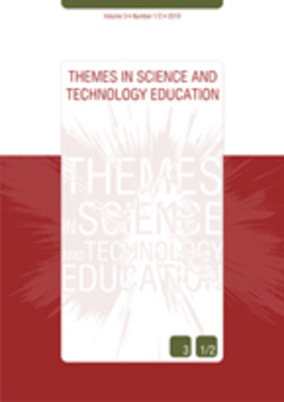Cultural viewpoint metaphors guiding the collaborative strategies design of a multitouch tabletop game for people with autism
Part of : Themes in science and technology education ; Vol.7, No.2, 2014, pages 83-98
Issue:
Pages:
83-98
Abstract:
Collaborative multitouch applications have been designed to support social interaction and collaboration skills in people with mild autism. However, this kind of application generally is not designed specifically for people with severe autism. We have proposed a set of collaborative strategies to manipulate the elements in the interface aiming to encourage the collaboration among users with severe autism. We applied this set of strategies in a collaborative multitouch game, named PAR. An empirical study with a group of users with autism using PAR, showed us the need to improve these collaborative strategies to provide a progressive learning of collaborative mechanisms. We conducted, therefore, the present qualitative study to inspect the intercultural experience promoted by PAR game in light of Cultural Viewpoint Metaphors (CVM), a conceptual tool of Semiotic Engineering theory. In this paper, we present the evaluation (by inspection) of the current intercultural situation of PAR, the identification of new features, and finally the redefinition of collaboration patterns with collaborative intercultural features intended for users with severe autism.
Subject:
Subject (LC):
Keywords:
Autism, Human-Computer Interaction, collaborative games, intercultural aspects
Notes:
Greis Silva and Luciana Salgado thank CAPES, CNPq and FAPERJ for supporting this research. Alberto Raposo thanks CNPq for the individual grant (process 310607/2013-2) and FAPERJ (Assistive Technology Program, process 190.243/2013).
References (1):
- APA (2000). Diagnostic and Statistical Manual of Mental Disorders. Washington, DC: American Psychiatric Association (4th edition).Battocchi, A., Pianesi, F., Tomasini, D., Zancanaro, M., Esposito, G., Venuti, P., Ben Sasson, A., Gal, E. & Weiss, P. L. (2009). Collaborative Puzzle Game: a tabletop interactive game for fostering collaboration in children with Autism Spectrum Disorders (ASD). In G. Morrison & S. Subramanian (eds.), Proceedings of ITS’09 ACM International Conference on Interactive Tabletops and Surfaces (pp. 197-204). NY: ACM.Bauminger, N., Goren-Bar, D., Gal, E., Weiss, P., Kupersmitt, J., Pianesi, F., Stock, O., & Zancanaro, M. (2007). Enhancing social communication in high-functioning children with autism through a co-located interface. In E. Petrakis (ed.), 9th IEEE Workshop on Multimedia Signal Processing (pp. 18-21). USA: IEEE.Chein, W. (2012). Multitouch Tabletop technology for people with autism spectrum disorder: A review of the literature. Procedia Computer Science, 14, 198-207.Daley, T. C. (2002). The Need for cross-cultural research on the pervasive developmental disorders. Transcultural Psychiatry, 39(4), 531-550.de Souza, C. S. (2005). The semiotic engineering of human-computer interaction. Cambridge, Mass.: The MIT Press.de Souza, C. S., & Leitao, C. F. (2009). Semiotic engineering methods for scientific research in HCI. Princeton, NJ: Morgan & Claypool.del Galdo, E. M., & Nielsen, J. (1996). International Users Interface. New York: John Wiley.Eco, U. (1976). A theory of semiotics. Bloomington: Indiana University Press.Fernandes, T. (1995). Global interface design: A guide to designing international user interfaces. New York: Academic Press.Geertz, C. (1973). The interpretation of cultures: Selected essays. New York: Basic Books.Giusti, L., Zancanaro, M., Gal, E., & Weiss, P. (2011). Dimensions of collaboration on a tabletop interface for children with autism spectrum disorder. In C. Gutwin, B. Begole & W. A. Kellogg (eds.), Proceedings of the SIGCHI Conference on Human Factors in Computing Systems (pp. 3295-3304). NY: ACM.Klin, A. (2006). Autism and Asperger syndrome: an overview. Revista Brasileira de Psiquiatria, 28, s3-s11.Marcus, A. (2001). Cross-cultural user-interface design. In M. J. Smith &, G. Salvendy (eds.), Proceedings of the Human-Computer Interface International (HCII) Conference (Vol. 2, pp. 502-505). NJ: Lawrence Erlbaum Associates.Marcus, A. (2001). International and intercultural user interfaces. In C. Stephanidis (ed.), User Interfaces for All: Concepts, Methods, and Tools (pp. 47–63). London: CRC Press.Orrú, S. E. (2008). Os estudos da análise do comportamento e a abordagem histórico-cultural no trabalho educacional com autistas. Revista Iberoamericana de Educación, 45(3). Retrieved 3 December 2014, from http://www.rieoei.org/deloslectores/1972Ester.pdf.Piper, A. M., O’Brien, E., Morris, M. R., & Winograd, T. (2006). SIDES: a cooperative tabletop computer game for social skills development. In P. Hinds & D. Martin (eds.), Proceedings of the 2006 20th Anniversary Conference on Computer Supported Cooperative Work (CSCW ’06) (pp. 1-10). NY: ACM.Salgado, L. C. C., Leitão, C. F., & de Souza, C. S. (2012). A Journey Through Cultures: Metaphors for Guiding the Design of Cross-Cultural Interactive Systems. Heidelberg: Springer.Silva, G. F. M., Raposo, A., & Suplino, M. (2014). PAR: A Collaborative Game for Multitouch Tabletop to Support Social Interaction of Users with Autism. Procedia Computer Science, 27, 84-93.Suplino, M. (2005). Natural functional curriculum: practical guide for education in autism and intellectual dissability/Curriculo functional natural: guia prático para a educação na área de autismo e deficiência mental. Coordenadoria Nacional para a Integração da Pessoa Portadora de Deficiência-CORDE. Braslia, Brazil.Tse, E., Greenberg, S., Shen, C., & Forlines, C. (2007). Multimodal multiplayer tabletop gaming. ACM Computers in Entertainment, 5(2). Retrieved 23 December 2014, from http://dl.acm.org/citation.cfm?id=1279552.Wakabayashi, A., Baron-Cohen, S., Wheelwright, S., & Tojo, Y. (2006). The Autism-Spectrum Quotient (AQ) in Japan: A cross-cultural comparison. Journal of Autism and Developmental Disorders, 36(3), 263-270.WHO (1992). ICD10-Classification of mental and behavioural disorders. Clinical descriptions and diagnostic guidelines. Geneva: Word Health Organization.Wing, L. (1988). The continuum of autistic characteristics. In E. Schopler & G. B. Mesibov (eds.), Diagnosis and assessment in autism. Current issues in autism (pp. 91-110). NY: Plenum Press.




